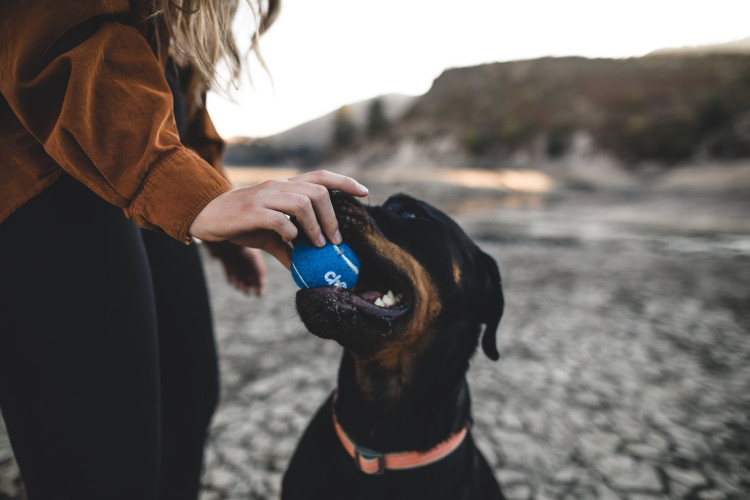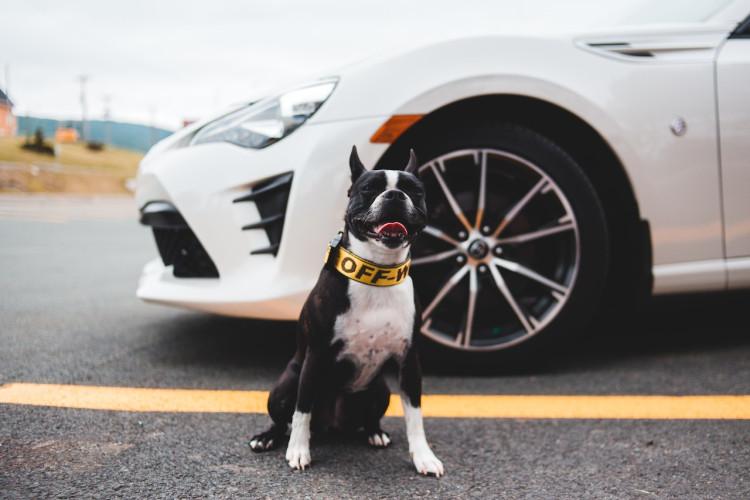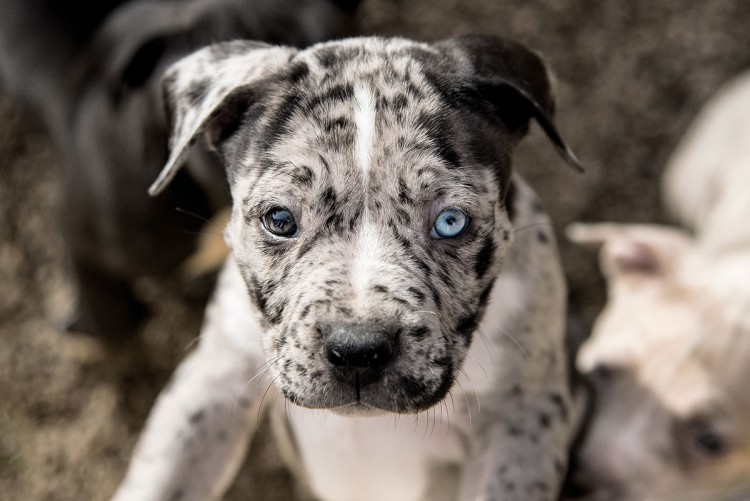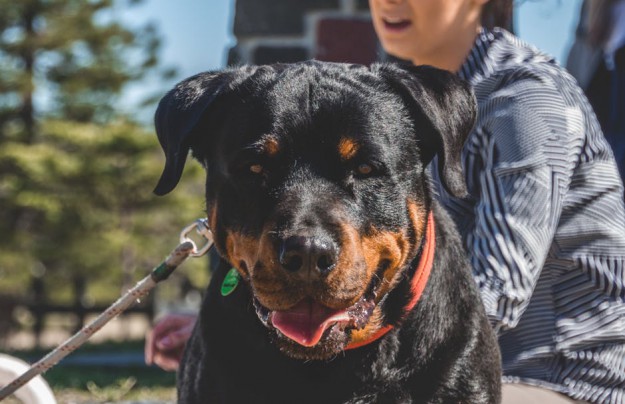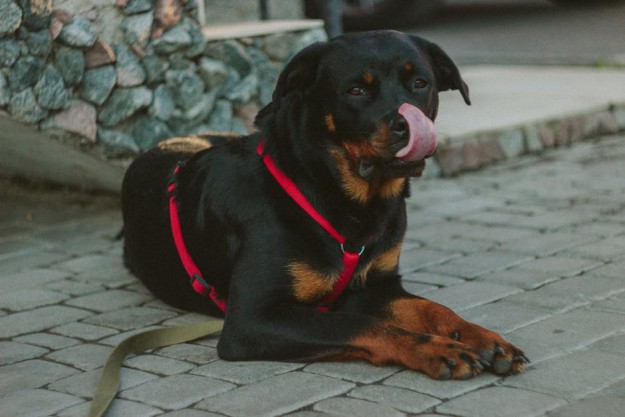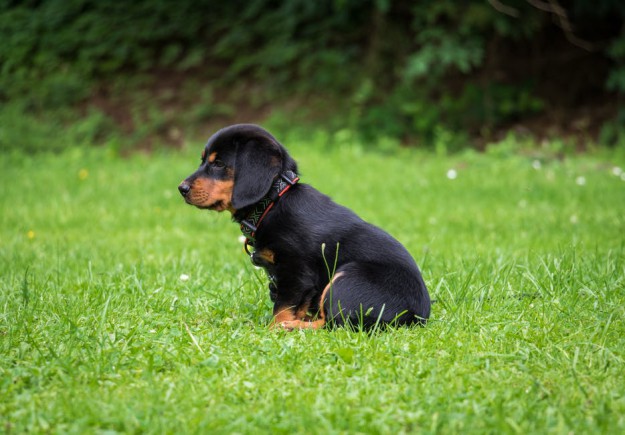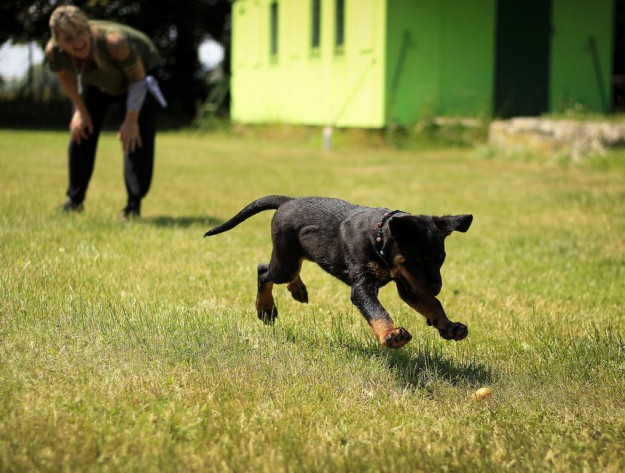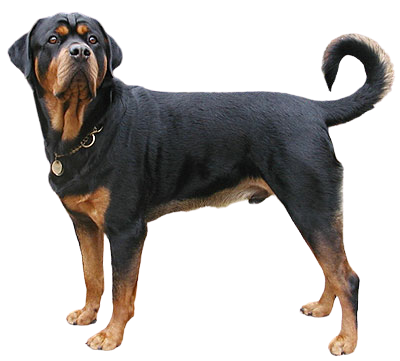
Rottweiler
USD $1200-$2000 Price Avg.
Working Dogs
Group
Purebred
Breed Type
Large, Giant
Size
8-11 years
Lifespan
Breed Information
| Group | Working Dogs |
|---|---|
| Popularity/Rank | 8 |
| Origin | Germany |
| Other Names | Rott, Rottie |
| Breed Type | Purebred |
| Price (Avg.) |
USD $1200-$2000
How much does a Rottweiler cost? According to a rough estimate, you will spend between $1200 to $2000 on your Rottweiler if you purchase it from a reputable breeder. If you select a dog with exceptional bloodlines, the price may be higher. The price might even be higher if the dog has already been trained. You'll usually pay less if you get a Rottweiler from a shelter. |
| Size | Large, Giant |
| Weight |
Male: 95-130 pounds (43-59 kg),
Female: 85-115 pounds (38-52 kg) |
| Height |
Male: 24-27 inches (61-69 cm),
Female: 22-25 inches (56-63 cm) |
| Lifespan | 8-11 years |
| Recognized by |
AKC, FCI
The American Kennel Club in 1931 as a Working breed. And FCI in the Pinscher and Schnauzer - Molossoid and Swiss Mountain and Cattledogs group, in the Molossian type s |
| Purpose | cattle driver, guardian, draft |
| Date of Origin | ancient times |
| Ancestry | German shepherd, Mastiff, Roman drover dog |
Appearance & Maintenance
| Coat | Dense |
|---|---|
| Coat Colors | Black, Mahogany, Rust, Tan |
| Grooming Level | |
| Shedding Level | |
| Eye Color Possibilities | Brown |
| Nose Color Possibilities | Black |
| Coat Color Possibilities | Black |
| Coat Length | Medium |
| Coat Density | Normal |
| Coat Texture | Wiry |
| Recommended Brushes | Deshedder, Nail Clipper, Slicker Brush |
| Brushing Frequency | Weekly |
Breed Characteristics
| Temperament | Alert, Brave, Courageous, Daring, Defensive, Fearless, Good-natured, Independent, Intelligent, Loyal, Protective, Vigilant |
|---|---|
| Intelligent | |
| Trainability | |
| Playfulness | |
| Sensitivity Level | |
| Affection Level | |
| Social Interaction Required | |
| Barking | |
| Watchdog Ability | |
| Territorial | |
| Biting Force | High |
| Mouthiness | |
| Impulse to Wander or Roam | |
| Prey Drive | |
| Adaptability | |
| Tolerates Being Left Alone | |
| Fighting Dog | Yes |
Good & Friendly with
| Apartment Life Friendly | |
|---|---|
| Stranger Friendly | |
| Kid-Friendly | |
| Cat Friendly | |
| Dog Friendly | |
| Office Friendly | No |
| Senior Citizens Friendly | |
| Pet Friendly | |
| Friendly with First Time Owners | No |
| Service Dog | Yes |
| Therapy Dog | Yes |
| Detection, Sniffer or Security Dog | Not really |
| Search and Rescue Dog (SAR) | Not really |
| Boat Dog | Not really |
| Cart Pulling or Drafting Dog | Yes |
Health Elements
| Health Issues | |
|---|---|
| Health Problems | Allergies, Aortic Stenosis, Bloat, Elbow Dysplasia, Hip Dysplasia, Hypothyroidism, Osteosarcoma, Panosteitis, Subvalvular Aortic Stenosis |
| Hypoallergenic | No |
| Energy Level | |
| Exercise Required | |
| Sleeping Required | |
| Weight Gain Potential | |
| Weather & Climate | Prefers average to warm weather conditions |
| Stinkiness | Medium |
| Drooling tendency | |
| Activity Level | Moderate |
| Rec. Walk Mileage Per Week | 10 miles |
| Minutes of Activity Per Day | 75 minutes |
Food & Costing
| Avg. Daily Food | Recommended daily amount: 4 to 10 cups of high-quality dry food a day, divided into two meals. |
|---|---|
| Cups Per Day | 3.3 cups |
| Daily Cost | $1.50 - $1.90 |
| Monthly Cost | $39.00 - $52.00 |
Reproducibility
| Gestation Duration | 60-64 days |
|---|---|
| How often can the Rottweiler have a litter? | Once a year. |
| Litter Size | 8-12 puppies (Once a year.) |
Description
The Rottweiler is a large, powerful breed of dog that has been around for centuries. They are known for their loyalty and intelligence, as well as their strength and courage. The Rottweiler is a popular breed of dog that is often used as a guard dog or police dog.
Appearance: The Rottweiler has a muscular body with short, dense fur that can be black with rust-colored markings or mahogany in color. They have broad heads with strong jaws and dark eyes. Their ears are triangular in shape and they have long tails that hang down to the ground when they walk.
Lifespan, Size, Weight & Colors: The average lifespan of the Rottweiler is 8-10 years old. They typically weigh between 80-135 pounds and stand between 22-27 inches tall at the shoulder. The colors of the Rottweiler can range from black to mahogany with rust-colored markings on their chest, legs, muzzle and eyebrows.
Personality: The Rottweiler is an intelligent breed that loves to please its owners but can also be stubborn at times if not properly trained or socialized early on in life. They are loyal companions who will protect their family fiercely if needed but also enjoy spending time playing games or going for walks together.
Friendliness: When it comes to other dogs, cats and children the Rottweiler can be friendly if properly socialized from an early age but may become aggressive towards strangers if not given proper training or guidance from its owners. With other animals such as horses or livestock they may show some aggression due to their natural instinct to protect what they consider theirs so it’s important to keep them away from these animals unless supervised by an adult at all times
Temperament: The temperament of the Rottweiler can vary depending on how it was raised but generally speaking they are calm yet alert dogs who love spending time with their families while still being able to take care of business when needed such as protecting them from danger or intruders if necessary
Health: Generally speaking the health of the Rottweilers is good however like any other breed there are certain health issues that may arise such as hip dysplasia which affects many large breeds including this one so it’s important for owners to keep up with regular vet visits in order to catch any potential problems before they become serious
Adaptability Level & Benefits As Pets: When it comes to adaptability level the rottie does well in both rural and urban settings however due to its size it may not do well in apartments unless given plenty of exercise each day which should include both physical activity such as running around outside along with mental stimulation through activities like obedience training classes etc.. As far as benefits go owning a rottie means having a loyal companion who will always be there for you no matter what plus since this breed loves being active you’ll never have trouble finding something fun for you two do together!
History
The Rottweiler is a large, powerful dog with a reputation for being aggressive. However, this breed is not naturally aggressive; in fact, they are gentle, loving, and loyal dogs. The Rottweiler's history is a long and complicated one, full of war, death, and near extinction.
The Rottweiler's ancestors were Roman cattle dogs. These dogs accompanied the Roman army as they conquered Europe; they were used to herd cattle and guard property. When the Romans withdrew from Germany in the 5th century AD, their cattle dogs were left behind. These dogs eventually bred with local breeds, resulting in the Rottweiler we know today.
During the Middle Ages, the Rottweiler was used as a working dog on farms and in butcher shops. They were also used as guard dogs and for hunting purposes. Unfortunately, during this time period there was little concern for breeding standards or record keeping; as a result, the Rottweiler's numbers dwindled dangerously low.
In 1882, the Verein für Deutsche Schäferhunde (German Shepherd Dog Club) was founded; this organization began to standardize the breeding of German shepherd dogs (which are closely related to Rottweilers). In 1907, another organization devoted to standardizing dog breeds, the Deutsche Kennel Club (DKC), was founded; however, they did not recognize the Rottweiler as a separate breed until 1931. By this time there were only about 30 purebred Rottweilers left in Germany!
Fortunately, the breed began to rebound in popularity after World War II. American servicemen who had been stationed in Germany during the war fell in love with these big black dogs and brought them back to the United States when they returned home. The Rottweiler quickly became one of America's favorite breeds; they are now ranked as the 8th most popular breed in the country!




